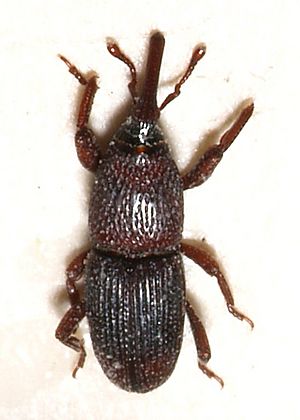Sitophilus facts for kids
Quick facts for kids Sitophilus |
|
|---|---|
 |
|
| Sitophilus granarius | |
| Scientific classification |
|
| Kingdom: | Animalia |
| Phylum: | Arthropoda |
| Class: | Insecta |
| Order: | Coleoptera |
| Family: | Curculionidae |
| Subfamily: | Dryophthorinae |
| Tribe: | Litosomini |
| Genus: | Sitophilus Schoenherr, 1838 |
| Species | |
|
14, see text |
|
Sitophilus is a group of small insects called weevils. These weevils are known for being common pests that cause damage to stored grains, nuts, and seeds. Some of the most well-known pest species include the rice weevil (S. oryzae), the wheat weevil (S. granarius), and the maize weevil (S. zeamais).
These tiny insects can destroy many important food items. They attack stored wheat, rice, sorghum, oats, barley, rye, and buckwheat. They also damage peas, cottonseed, and processed foods like pasta. Even root crops like cassava and fruits such as apples can be affected by Sitophilus weevils.
Contents
Where Do Sitophilus Weevils Live?
The rice weevil and maize weevil can be found almost everywhere in the world, especially in warmer areas. In cooler parts of Europe, you are more likely to find the wheat weevil instead.
Life Cycle of Sitophilus Weevils
The female weevil starts by making a small hole in a single grain, nut, or seed. She then lays one egg inside this hole. After laying the egg, she seals the hole with a special liquid.
The baby weevil, called a larva, grows inside the grain. It eats the inside of the grain as it develops. Once it is fully grown, it changes into a pupa. Finally, it becomes an adult weevil and leaves the grain, often leaving it completely hollow.
What Do They Eat?
The wheat weevil can live on acorns. Scientists think they might have eaten acorns before humans started growing lots of grain. The rice weevil can eat beans, nuts, grains, and even some fruits like grapes.
Other Sitophilus species eat the acorns from different types of oak trees. Some also eat seeds from trees in the Dipterocarpaceae and legume families. For example, the tamarind weevil (S. linearis) only eats the seeds of the tamarind tree.
Weevils and Bacteria
Some Sitophilus weevils have a special relationship with tiny bacteria inside their bodies. This is called a symbiotic relationship. The bacteria help the weevil by making important nutrients like amino acids and vitamins. This helps the weevil stay healthy, especially when its diet of grains might not have all the nutrients it needs.
Different Kinds of Sitophilus Weevils
As of 1993, there are about 14 known species in the Sitophilus group.
Here are some of them:
- Sitophilus conicollis
- Sitophilus cribrosus
- Sitophilus erosa
- Sitophilus glandium
- Sitophilus granarius – also known as the wheat weevil or granary weevil
- Sitophilus linearis – the tamarind weevil
- Sitophilus oryzae – the rice weevil
- Sitophilus quadrinotatus
- Sitophilus rugicollis
- Sitophilus rugosus
- Sitophilus sculpturatus
- Sitophilus vateriae
- Sitophilus zeamais – the maize weevil
Scientists have also found very old Sitophilus weevils as fossils. One example is:
- Sitophilus punctatissimus
See also
 In Spanish: Sitophilus para niños
In Spanish: Sitophilus para niños

